Building a Segbot (with a Completed Board)
<- Previous Step
Next Step ->
Wireless Options
There is a variety of wireless options available for the Segbot. You may use the CC1111EMK868-915 Evaluation Module Kit to allow remote control of the Segbot by the eZ430-Chronos-915 watch, you may use AeroComm 4490-200A RF transcievers and the custom AeroComm PC Interface board for a wireless serial connection (you will need to have this fabricated:
more info), or you may choose to use no wireless at all. If you decide to use wireless, you should decide at this point whether you want to be able to use the Chronos watch or if you want to use the AeroComm devices. Since both devices operate at 915MHz, we have found that it is best to use only one type of wireless at a time due to interference. If you are chosing not to use wireless, skip to the next step. Otherwise, see one of the options below.
AeroComm
In order to use the AeroComm wireless modems, you will need to have an AeroComm AC4490 PC Interface card made. Please see
this page for more information on getting that fabricated. Once the interface card is constructed, you will need to program both of the AeroComm devices so that they communicate properly. In order to do this, you will need to download the "Configuration Utility" from the Software Downloads category of
this page. Once you have the program installed, insert one of your AC4490 cards into the interface board, and then power the the board. Open the installed program and go to the "PC Settings" tab. Once there, make sure "USB / Comm Port" is selected under the Port1 Settings box. With the correct port selected and the other settings as shown in the following screenshot, click "Open Port."
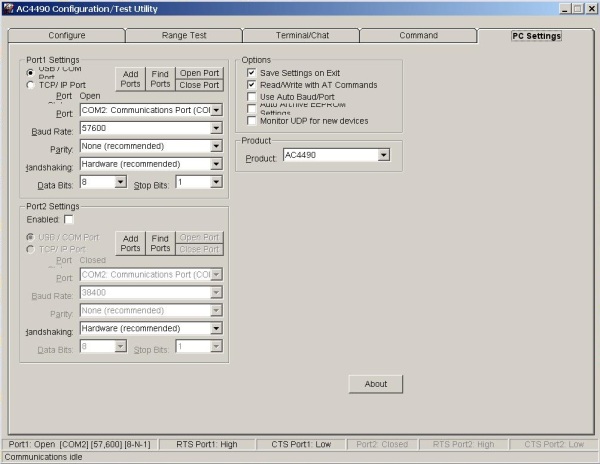
Once the port is open, go to the "Configure" tab and click the "Read Radio" button. It should successfully read the default setup for the card. Next, set up the configuration as shown in the screenshot below. You will need to put in the correct MAC address for your other device in the "Destination" entry box. This MAC address is the number directly below the bar code on the back side of your Aerocomm card. Additionally, you need to program one of your cards as a "Client" and one as a "Server." You can make this distinction using the "Mode" dropdown box. Also, you may change RF Channel ID and the System ID from what is shown in the screenshot, but make sure the IDs match on both cards. After you have set up the configuration for a card, make sure to click "Write Radio" and then click "Read Radio" to make sure the changes were written correctly. When you are satisfied, remove the card from the interface device and program the other AeroComm card. After you have programmed both AeroComm cards, leave the "Server" card plugged into the interface device. The "Client" card will plug into the Segbot.

You should attach the connector to the board now, as it is easier to do before the board is installed in the plastic shell. The parts required to install the connector to the board are shown below:
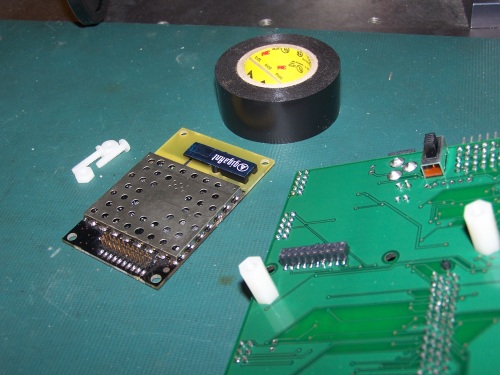
We have found that there are many noise issues with this card and the IR sensors. To combat these, remove the antenna (it pulls of easily), and make sure it is placed on the back side of the board. It should appear as it does in the following picture:
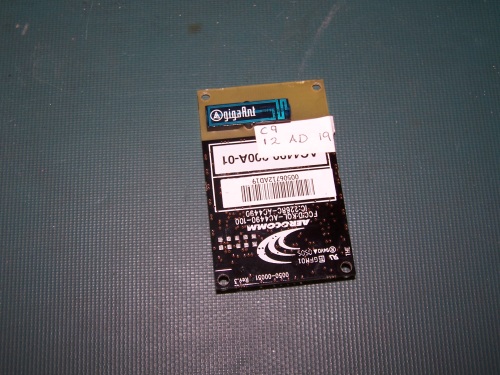
As an additional measure to reduce noise and prevent any shorting should the card be bent into touching the main board, attach a small amount of electrical tape over the shielding on the connector card. It should appear as the card in the following picture:

Connect the connector to the board by plugging it in to the surface mount header on the back of the board. Next, drop the plastic screws through the wireless connector and hand tighten the nuts on to the screw ends on the top side of the board. Tighten the nuts such that the Aerocomm board is not touching the main board, but not so tight that the Aerocomm board is severely bent away from the main board. It should appear similar to what is shown below:
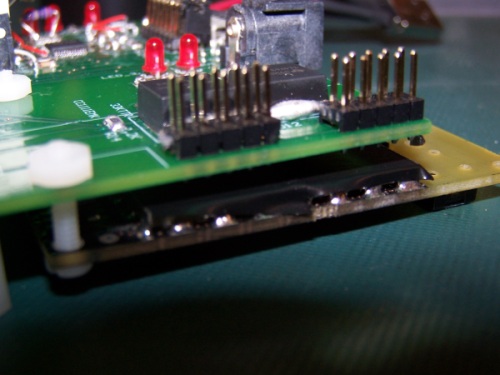
CC1111 Wireless and Chronos Watch
In order to use the CC1111 Wireless device, you need to be able to program it correctly. At this time, version 8.1 of IAR for Intel-8051 architecture is unable to program this card correctly (see
this page for more information). If you have access to a slightly older version of IAR for 8051 architecture (we use IAR v7.67, you need at least IAR v7.51A), you may still be able to program the device. If you don't have access, because the most recent free Kickstart version is the only one available from IAR,
contact us and we will program the device for you using our equipment. If you want to try to program it yourself with an older version of IAR, you will need a
CC Debugger from TI. Our project code is available for download
here. The code is a modified version of TI's default project.
To install the CC1111 after it has been correctly programmed, simply plug it in to the "Test" and "Debug" headers at the top right corner of the main board. It should appear as it does in the picture below.
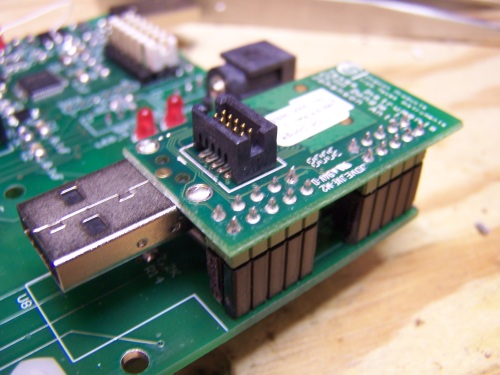
<- Previous Step
Next Step ->
Home ♦ Updates ♦ Videos ♦ Contact Information






